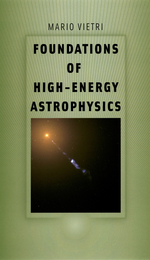
The most thorough and engaging survey of high-energy astrophysics available today, Foundations of High-Energy Astrophysics introduces the main physical processes relevant to the field in a rigorous yet accessible way, while paying careful attention to observational issues. Vietri’s book will quickly become a classic text for students and active researchers in astronomy and astrophysics. Those in adjoining fields will also find it a valuable addition to their personal libraries.

When the first X-ray detectors revealed many places in the universe that are too hot to be seen by optical and radio telescopes, pioneering X-ray astronomers realized they were onto something big. They knew that a large X-ray observatory must be created if they were ever to understand such astonishing phenomena as neutron stars, supernovas, black holes, and dark matter. What they could not know was how monumental in time, money, and effort this undertaking would be. Revealing the Universe tells the story of the Chandra X-ray Observatory.
From the first proposal for a large X-ray telescope in 1970 to the deployment of Chandra by the Space Shuttle Columbia in 1999, this book chronicles the technical feats, political struggles, and personal dramas that transformed an inspired vision into the world's supreme X-ray observatory. With an insider's knowledge and a storyteller's instincts, Wallace and Karen Tucker describe the immense challenges that this project posed for such high-tech industry giants as TRW, Eastman Kodak, and Hughes Danbury Optical Systems (now Raytheon Optical Systems). Their portrayal of the role of NASA is itself an extraordinary case study of multibillion-dollar government decisionmaking, and a cautionary tale for future large space astronomy missions.Revealing the Universe is primarily the story of the men and women whose discoveries, skills, failures, and successes made the Chandra X-ray Observatory possible.

Beyond the range of optical perception--and of ordinary imaginings--a new and violent universe lay undetected until the advent of space exploration. Supernovae, black holes, quasars and pulsars--these were the secrets of the highenergy world revealed when, for the first time, astronomers attached their instruments to rockets and lofted them beyond the earth's x-ray-absorbing atmosphere.
The X-Ray Universe is the story of these explorations and the fantastic new science they brought into being. It is a first-hand account: Riccardo Giacconi is one of the principal pioneers of the field, and Wallace Tucker is a theorist who worked closely with him at many critical periods.
The book carries the reader from the early days of the Naval Research Laboratory through the era of V-2 rocketry, Sputnik, and the birth of NASA, to the launching of the Einstein X-Ray Observatory. But this is by no means just a history. Behind the suspenseful, sometimes humorous details of human personality grappling with high technology lies a sophisticated exposition of current cosmology and astrophysics, from the rise and fall of the steady-state theory to the search for the missing mass of the universe.
READERS
Browse our collection.
PUBLISHERS
See BiblioVault's publisher services.
STUDENT SERVICES
Files for college accessibility offices.
UChicago Accessibility Resources
home | accessibility | search | about | contact us
BiblioVault ® 2001 - 2024
The University of Chicago Press









